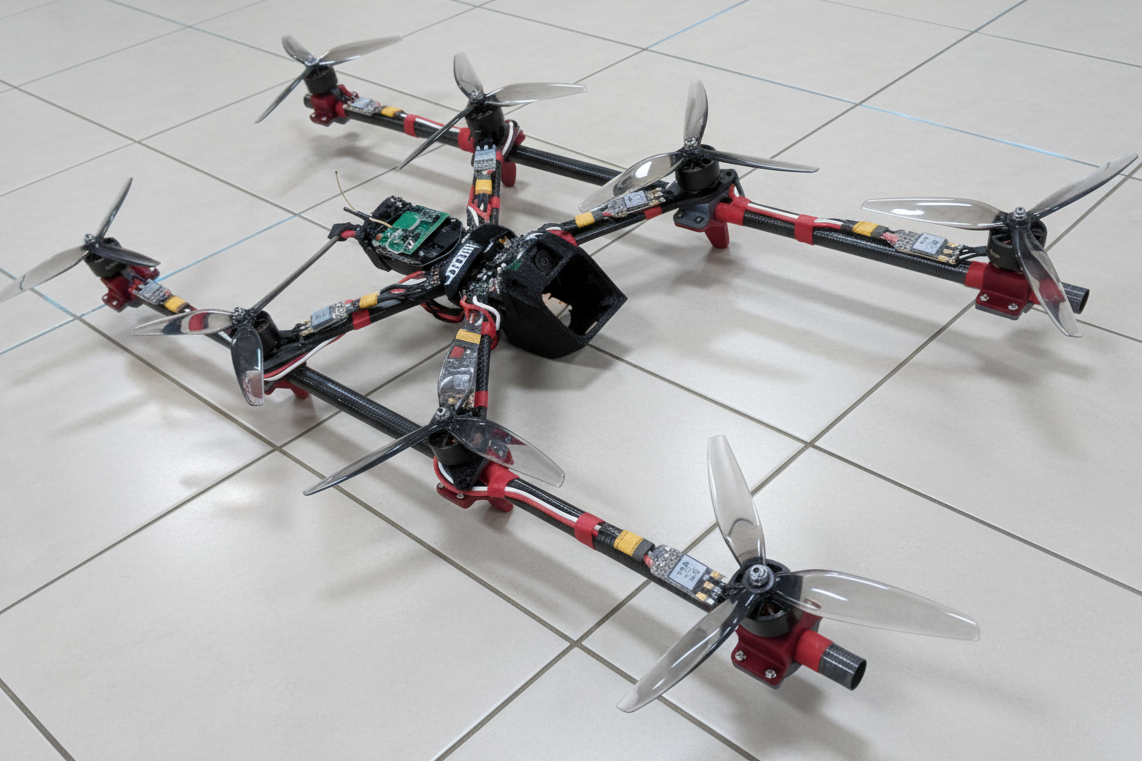H-Frame Modular Payload Drone Development
Role: Lead Mechanical Engineer / Hardware Prototyping Lead
Organization: Drone Racing League (DRL)
Objective: Develop a compact yet high-thrust, eight-motor modular drone platform optimized for payload flexibility and indoor operation
During my tenure with the Drone Racing League, I led the mechanical design and prototype development of a novel H-frame octocopter platform, a configuration rarely used in the industry but intentionally engineered for modular payload applications and tight-space flight environments. The goal was to create a lightweight yet rigid frame architecture that could handle heavier payloads while maintaining stability and maneuverability in confined indoor spaces such as arenas, warehouses, and film studios.
Structural Design and Frame Architecture
The H-frame architecture was designed to maximize thrust efficiency and payload capacity while minimizing overall width. The narrow frame allowed the aircraft to fly through standard doorways, enabling seamless operation in controlled indoor environments.
I developed the primary chassis structure using carbon fiber (CF) tubes for the main longitudinal and lateral beams, chosen for their exceptional stiffness-to-weight ratio and vibration-damping characteristics. The modular nature of the CF tubing system allowed rapid reconfiguration for different motor setups, payload sizes, and thrust distributions.
To complement the carbon fiber frame, I designed custom 3D-printed joint brackets that served as both structural connectors and vibration isolators. These brackets integrated polyurethane dampeners wrapped around the carbon tubes, significantly improving the drone’s ability to absorb mid- to high-frequency vibrations generated by the motors and propellers. The hybrid approach combined lightweight additive manufacturing with aerospace-grade composite materials, resulting in a durable and easily modifiable platform.
Propulsion Configuration and Payload Handling
The drone utilized an eight-motor (octocopter) configuration, doubling the thrust output compared to conventional quadrotors while distributing load evenly across the structure. This configuration was specifically optimized for payload stability and redundancy—critical factors for professional cinematography, mapping, and LiDAR scanning missions.
Each motor was mounted within a modular 3D-printed housing integrated into the bracket system, providing both motor alignment precision and structural reinforcement. I incorporated quick-swap motor mounts and wire channels to simplify assembly and maintenance while ensuring optimal center of gravity alignment for various payload configurations.
Vibration Challenges and Structural Optimization
One of the most significant engineering challenges in this design was managing excess vibration throughout the carbon fiber frame, which caused sensor noise and control instability during early test flights.
To address this, I implemented a combination of:
FEA (Finite Element Analysis) using SolidWorks Simulation to identify high-stress flex zones;
Dynamic stiffness tuning via redesign of the printed brackets to increase torsional rigidity;
Custom damping inserts made from urethane-infused polymer rings embedded between bracket layers, reducing resonant harmonics by over 30% in bench vibration tests.
The refined frame achieved a stiffer yet lighter structure, eliminating the need for external dampers while maintaining an integrated, clean aesthetic. This resulted in a highly stable flight platform capable of supporting payloads beyond its original design target without compromising handling.
Rapid Prototyping and Iteration
All custom components were modeled in SolidWorks and fabricated using 3D printing technologies for rapid iteration. Multiple versions of the frame were printed using carbon-fiber-reinforced nylon (PA-CF) and PETG-CF, selected for their dimensional stability and thermal resistance.
Each prototype underwent bench testing and flight evaluation, with iterative adjustments made to arm lengths, bracket infill densities, and damping hardness to balance stiffness and flexibility.
The final prototype demonstrated exceptional thrust efficiency and structural integrity, establishing a foundation for a production-ready modular drone platform adaptable to multiple payloads, including cameras, sensors, and communication equipment.
Outcome and Impact
The H-frame modular drone successfully proved the concept of a narrow-profile, high-payload multirotor system suitable for confined environments and adaptable mission requirements. By combining composite materials, 3D-printed components, and vibration-tuned structural integration, the design achieved high mechanical efficiency, ease of assembly, and modular scalability—an approach now influencing DRL’s next-generation performance platforms.
Miaden Test Flight




